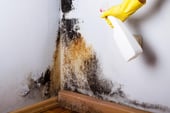How To Handle Mold And Avoid Liability As A Contractor
 Mold remediation experts are not the only contractors who encounter mold on a fairly regular basis. Often times, the homeowner does not learn that there is mold in their house until a contractor points it out. This may be a restoration contractor, an HVAC contractor or even a plumbing contractor. Read on to find out how contractors can handle mold at their job sites and avoid liability.
Mold remediation experts are not the only contractors who encounter mold on a fairly regular basis. Often times, the homeowner does not learn that there is mold in their house until a contractor points it out. This may be a restoration contractor, an HVAC contractor or even a plumbing contractor. Read on to find out how contractors can handle mold at their job sites and avoid liability.
Contractors should always warn homeowners if they spot mold on the job even if that is not why they are there. Mold can pose a serious risk to the foundation of the home as well as the health and safety of the inhabitants. The homeowner can then contact an Indoor Environmental Professional (IEP) to fully diagnose the problem.
This should be good news to the homeowner. However, this puts the contractors in a tough position. Over the past few years, there have been a growing number of lawsuits against contractors who pointed out the mold to the homeowner. The homeowners often attempt to place the blame on the contractors as the source of the mold, but why?
A Way Out For The Insurance Companies
The number of claims made to insurance companies regarding mold damage began to skyrocket in the 90s and 2000s. This was good for the homeowner because the insurance providers paid to have the mold removed and the area restored. It was also good for the restoration contractors because the insurance companies were paying them to do their job. The only entity that didn't benefit from this growing awareness was the insurance provider who had to cover the costs.
Insurance companies found a way out of this predicament by including new and more severe mold exclusion clauses in their policies. This meant the insurance companies were no longer paying for mold remediation. The funds had to come from the homeowner, the contractor, a lender, or a third-party source.
Homeowners didn't want to be stuck with the bill so they began opening lawsuits against contractors claiming that the mold was a result of their work. This greatly increased the risk of working for homeowners as well as in commercial buildings.
How Can Contractors Avoid Liability?
Contractors must rely on their own insurance policies to avoid liability in many cases. Their Commercial General Liability (GPL) insurance policy is a standard tool of protection. However, there is a pollution exclusion clause included in this policy. The exclusion states that the insurance does not cover any bodily or property harm caused by the escape, dispersal, or release of pollutants.
Whether mold is considered a pollutant that is not covered by this policy is a widely debated issue. Court cases often tip one way or another without offering any universal standings. Some cases have found the policy to be too ambiguous with their definition of pollution. Others have classified mold as an airborne pollutant.
 Contractors are not advised to leave their career up to chance. Instead, contractors should consider investing in new insurance policies that are specifically designed to cover mold and pollutants. (As well as the standard GPL policy) Contractors Pollution Liability (CPL) covers liability for such pollutants with a clear definition that includes mold or fungi.
Contractors are not advised to leave their career up to chance. Instead, contractors should consider investing in new insurance policies that are specifically designed to cover mold and pollutants. (As well as the standard GPL policy) Contractors Pollution Liability (CPL) covers liability for such pollutants with a clear definition that includes mold or fungi.
CPL may be the best tool currently available for contractors to avoid liability when mold is discovered on a property. That is in addition to proper risk management. Properly managing risk means carefully choosing what customers to work with and how the problem is approached if detected.
Dealing With Customers
The customers a contractor chooses to work with, how well they document their work, and how they approach the customer regarding mold will play a big role in how the situation unfolds. First, it's a good idea to avoid working with customers that already seem disgruntled with insurance companies.
This is especially true for mold remediation contractors where the homeowner already knows of the problem and isn't happy that their insurance policy doesn't cover the loss. They may still try to pin further damage on the contractor that outweighs the bill for the services provided. These customers are time bombs that should be avoided when possible.
Addressing the issue as carefully as possible is the final point of recommendation. It's important for contractors to put themselves in the homeowner's position. Mold remediation can be expensive work and the insurance providers have dumped the costs on the homeowner. They need to approach the subject carefully, with empathy, and with a proper course of action.
Risk Exists
It is impossible to work as a contractor and avoid risk altogether. However, by utilizing ethical work standards, by carefully choosing and approaching customers, and by adding CPL policies to their arsenal they can greatly reduce the risk associated with mold.

Guest Blogger: R.S. Hall is the owner of several successful businesses and the publisher of the website www.moldremovalrescue.com which provides solutions for mold problems.








